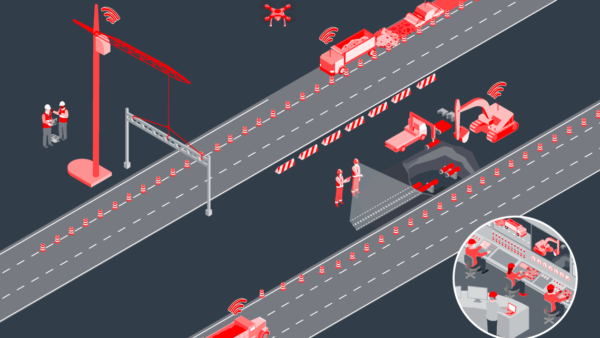AmeyVTOL has successfully demonstrated the first drone inspection of UK infrastructure to go beyond visual line of sight (BVLoS).
During the demonstration, AmeyVTOL’s innovative VTOL Flying Wing surveyed an area of 2km autonomously and out of the sight of the pilot. Previously, drone inspections have been limited to flight within visual line of sight (WVLoS) and as such, could not go further than 500 metres from the pilot.
The successful trial opens up significant possibilities for BVLoS inspections of long linear infrastructure such as roads, railways and overhead power lines.
The VTOL Flying Wing can fly up to 100km on a single charge due to a unique hybrid design and an optimised energy system. Preparation and execution of the trial was made possible through AmeyVTOL’s state-of-the-art operational control centre, which enables the planning, simulation, and remote monitoring of BVLoS drone operations. Advanced communications and simulation capabilities were developed in partnership with Collins Aerospace.
Alex Gilbert, managing director of Amey Consulting, said: “We are delighted to have successfully trialled a UK first for asset management. Through our collaboration with SME VTOL Technologies we have developed a genuine innovation that could transform inspections and surveys for asset owners in both the public and private sector. Being able to go beyond visual line of sight will not just provide safer, more effective inspections, but it will empower asset managers with increasingly reliable data, resulting in informed, intelligent decision making.”
The demonstration project was part of a government-sponsored Rail First of a Kind (FOAK) programme promoted by Innovate UK through the Small Business Research Initiative (SBRI).
In a separate development, an international drone expert has welcomed the recent move by the Department for Transport to deliver medicines and supplies via drones as a response to Covid-19.
Robert Garbett, chairman of the Drone Delivery Group and chairman of the British Standards Institution Drone Committee, said: “This move by the Department for Transport will open the way to accelerated growth of the UK drone industry, and provides the opportunity for UK plc to become a world leader in this fast growth technology.”
However, Garbett played down the popularly envisaged application of deliveries by small drones. “This would be the least practical and least achievable application for air drones yet conceived. The issues associated with implementing such a concept for widespread household delivery are huge, for instance safety, security and the need for expensive infrastructure to make widespread use practical even in the medium term.”
Instead, Garbett predicts the evolution of delivery by drones will take the following forms:
- Mid-mile delivery – The bulk transportation of cargo from storage hub to storage hub, or from airport to storage hub for onward delivery to increase capacity into remote and hard to reach areas or during emergencies, (such as the delivery of medicines and supplies during the current pandemic) or where access is temporarily restricted.
- Limited last-mile delivery – The delivery of items between locations where rapid delivery will save or significantly improve quality of life, such as medical supplies, medicines, organs and blood between or to hospitals.
- Industrial delivery applications – The movement of cargo and assets around industrial and transportation locations such as refineries, airports, or large logistics locations and smaller internal delivery operations for the delivery of mail, spares or tooling; and
- Blue light support – The movement of supplies and equipment in support of blue light operations such as accident and traffic management, crime scene management and terrorist or public safety incident handling.
Garbett added: “In order to achieve this fast, all stakeholders in the drone industry must recognise the need for drone testing areas for applications to be developed safely and effectively, as reinforced by the UK government’s initiative, and must work closely with regulators and standards makers to convey ‘lessons learned’ and to facilitate wider-scale adoption.”













